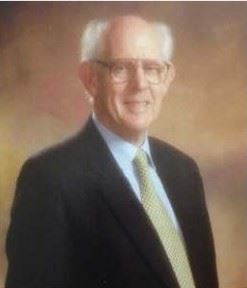Mervyn Peel BSc MSc PhD MRSC
1925-2020
Member of the Royal Society of Chemistry since 1956, Mervyn joined Nipa Laboratories Ltd in 1941, working on the creation of antioxidants to extend the life of food stuffs, supporting the war effort by preserving supplies, reducing food waste and the need for imports. In 1951 he left to study for his MSc, graduating 9 months later.
In 1952 Mervyn moved to Hertfordshire where he joined the Research Team of Pharmaceutical company Allen & Hanburys Ltd, in Ware, as a Senior Scientist, and studied for his Doctorate through the University of London, culminating with his thesis “Brief-acting Hypnotics: Studies in the Synthesis and Properties of New Derivatives of Thiobarbituric and Barbituric Acids”. Allen and Hanburys was absorbed by Glaxo Laboratories in 1958, and Mervyn now entered his most prolific and enjoyable research period. Talking shortly before his death, he was most proud of the work he was involved with at this time, particularly regarding a compound that enabled pharmacologists to explore further the role of acetyl choline in nerve terminals. It was given the number AH 5183.

In 1961 Allen & Hanburys decided to focus on pharmacology-based research. The overall strategy would focus on rational approaches to discover new medicines for common diseases. Targets included pain, blood pressure and bronchial asthma. Mervyn initially worked closely with Dr.John Hunt, including research into a short acting anaesthetic. The potential compound however caused palpitations in some patients, and further development was halted.
He switched to 4-phenylpipridine derivatives which had analgesic properties and were patented in July 1965. The inventors were D.Jack, N.J.Harper, A.C.Ritchie and M.E.Peel.
One of the compounds used in this project, N-nitroso-4-phenylpiperidine, was later used by Mervyn in the late 1960’s in a photochemical reaction with cyclohexene to produce 2-(4-phenylpiperidino) cyclohexanol, AH 5183 or Vesicamol, as it became known. This compound unexpectedly acted as a neuromuscular blocking agent and its mechanism of action has been widely studied and many chemical analogues have been prepared by others. Some 700 papers cite AH 5183.
Mervyn and his team also worked on a project looking for compounds that showed anti-allergic activity in a pharmacological model that demonstrated the inhibition of the release of histamine from mast cells. Intal, a marketed medicine used to treat asthma, had this activity. Some of the active compounds from this programme were patented.
Colleagues remember Mervyn as someone who was always helpful, supportive, kind and friendly. He took a keen interest in how new chemists settled in as the research department expanded. He was appointed Departmental Administrator to assist in this expansion in addition to his role as a Senior Scientist.
In 1976 he became Head Safety Advisor for the Glaxo site at Ware, responsible for the safety of over 1,100 employees. He proved to be very conscientious in this role and held the position for 12 years before retiring in 1987. His real love however, would always be as a Research Chemist. Outside of Glaxo, Mervyn was a member, then Secretary, then Chairman, of The Fine Chemicals group of The Society of Chemical Industry, with his tenure ending in 1977. He was a Scientific Advisor to Hertfordshire County Council, and Chairman of the Harlow and District Welsh Society for many years. His love of rugby, and Welsh rugby in particular, stayed with him throughout his life. On retiring he took up golf, playing with a very respectable handicap once or twice a week, and enjoyed drawing and watercolour painting.
In 2004 Mervyn moved to Sevenoaks in Kent. Mervyn is survived by Barbara, his wife of 65 years, his three daughters, 6 grandchildren, and great grandson.
Disclaimer
The Royal Society of Chemistry is not responsible for individual opinions expressed on this page.
